Mirror images can dramatically elevate your mobile photography game by adding depth, symmetry, and visual intrigue to your shots. They transform ordinary scenes into enchanting compositions, creating a sense of balance and harmony. You'll find endless creative possibilities using natural reflections in water bodies, urban architecture, or even small puddles. These reflective surfaces allow you to play with light, shadows, and perspective, resulting in unique and eye-catching images. By mastering the art of reflection photography, you'll develop a keen eye for compositional elements and learn to see the world from fresh angles. Dive deeper to reveal the full potential of mirror imagery in your mobile photography.
Understanding Mirror Image Composition
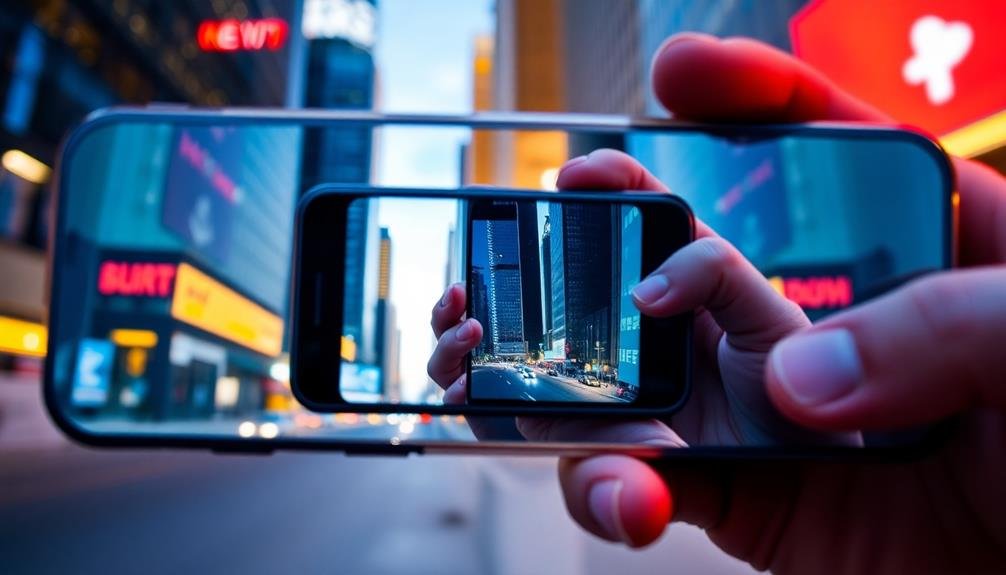
Almost every photographer has encountered mirror images, whether in nature or urban settings. These enchanting compositions occur when a reflective surface creates a near-perfect duplicate of the subject. To master mirror image composition, you'll need to understand its key elements and how to manipulate them.
First, identify suitable reflective surfaces. Water bodies, glass windows, polished floors, and even puddles can serve as your mirror.
Next, consider the angle of reflection. You'll achieve the best results when your camera is positioned at a 45-degree angle to the reflective surface. This allows you to capture both the subject and its reflection clearly.
Pay attention to symmetry. A well-balanced mirror image should have the reflection line running horizontally through the center of your frame. However, don't be afraid to break this rule for creative effect. You can also play with partial reflections or distorted mirrors to add intrigue.
Lighting is essential in mirror image photography. Soft, diffused light often works best, but dramatic lighting can create stunning contrasts.
Experiment with different times of day to find the perfect balance between subject and reflection.
Finding Natural Reflective Surfaces
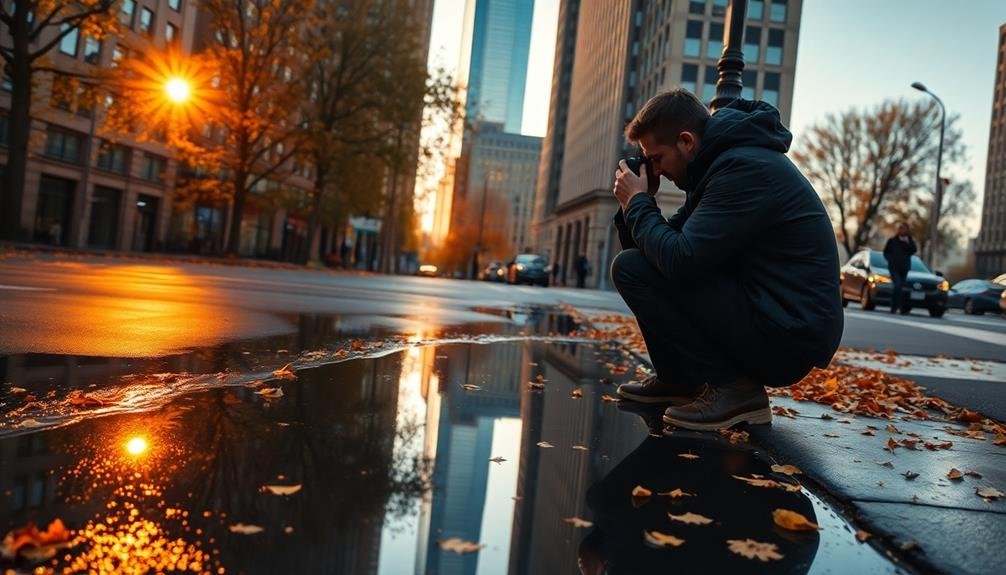
When seeking natural reflective surfaces for mirror images, you'll find water bodies and puddles to be excellent choices.
Look for calm lakes, still ponds, or even rainwater puddles on streets to capture stunning reflections.
Additionally, you can explore urban environments for reflective architecture, such as glass-fronted buildings or polished metal surfaces, which offer unique opportunities for creative mirror imagery.
Water Bodies and Puddles
For capturing stunning mirror images in mobile photography, water bodies and puddles offer an abundance of natural reflective surfaces. You'll find these reflective opportunities in various settings, from urban landscapes to natural environments. Look for calm lakes, rivers, and even small puddles after rainfall to create enchanting symmetrical compositions.
When shooting reflections in water, pay attention to the water's surface. A still surface produces clearer, more defined reflections, while a slightly rippled surface can add an artistic, abstract quality to your images.
To maximize the reflection's impact, position yourself at a low angle, closer to the water's surface. This technique will increase the reflection's prominence in your frame.
Experiment with different subjects reflected in water bodies. Architectural elements, trees, mountains, and even people can create compelling mirror images.
Don't forget to contemplate the time of day; early morning or late afternoon often provide the best lighting conditions for reflective photography. Adjust your phone's exposure settings to balance the brightness between the reflected subject and its mirror image, ensuring both elements are well-exposed in your final shot.
Reflective Urban Architecture
Moving from natural reflections to the urban jungle, you'll find a wealth of reflective surfaces in modern architecture. Glass-clad skyscrapers, polished metal facades, and mirrored installations offer endless opportunities for capturing stunning mirror images.
Look for buildings with large windows or sleek exteriors that can reflect their surroundings, creating fascinating juxtapositions of structure and sky.
Pay attention to the time of day and weather conditions. Early morning or late afternoon light can produce dramatic reflections, while overcast days might yield softer, more ethereal images.
Don't overlook smaller reflective surfaces like shop windows, car hoods, or even public art installations. These can provide unique perspectives and abstract compositions.
Experiment with angles and framing to create intriguing compositions. Try shooting from low angles to capture more of the reflected image, or focus on specific architectural details that create interesting patterns when mirrored.
Use leading lines and symmetry to guide the viewer's eye through your composition. Remember to keep your lens clean and steady to guarantee sharp, clear reflections.
With practice, you'll start seeing reflective opportunities everywhere in the urban landscape.
Creating Symmetry in Your Shots
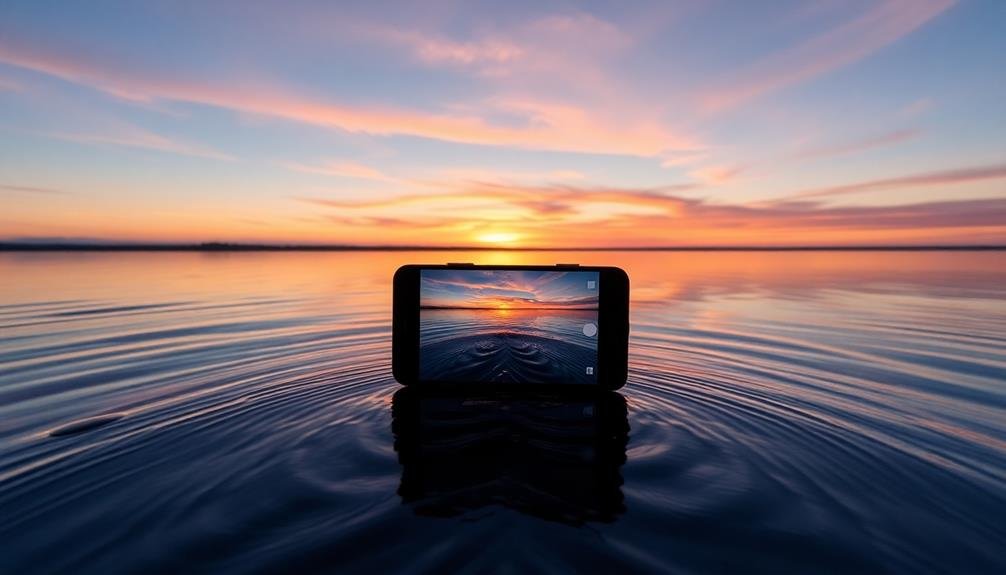
In light of the growing trend toward symmetrical compositions, creating balance in your mobile photography has become crucial. To achieve perfect symmetry, you'll need to master a few key techniques. First, find a strong central focal point that naturally divides your frame. This could be a building, a road, or a natural feature. Next, position yourself so that this focal point is dead center in your shot.
Use your phone's grid feature to align elements precisely. Don't forget to check your edges – guarantee both sides of the frame mirror each other as closely as possible. Post-processing apps can help fine-tune your symmetry if needed.
Here's a quick guide to symmetrical composition types:
| Type | Description | Best Used For |
|---|---|---|
| Vertical | Split down the middle | Tall structures, reflections |
| Horizontal | Split across the middle | Landscapes, horizons |
| Radial | Circular symmetry | Domes, flowers, spirals |
| Diagonal | Split corner to corner | Dynamic action shots |
Playing With Light and Shadows
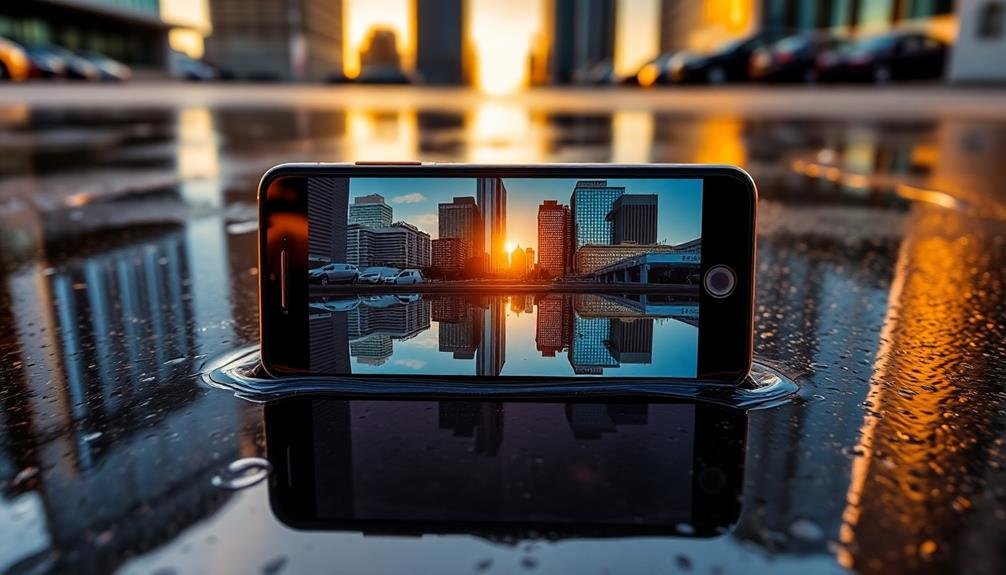
Light-and-shadow play can transform your mobile photos from ordinary to extraordinary. When creating mirror images, mastering this technique adds depth and intrigue to your shots.
Start by seeking out high-contrast scenes where light and shadows create distinct patterns. Early morning or late afternoon sun works best, casting long shadows that can be mirrored for dramatic effect.
Experiment with silhouettes by placing your subject between the light source and your camera. This technique creates a bold, dark shape against a bright background, which can be mirrored for a striking symmetrical image.
Don't shy away from harsh midday sun; use it to capture sharp, geometric shadows on flat surfaces like walls or pavements.
For indoor shots, try using artificial light sources to craft interesting shadow patterns. Window light can create soft, diffused shadows, while directional lamps produce more defined shapes.
Play with angles and distances to manipulate shadow size and intensity.
Editing Techniques for Reflection Photos
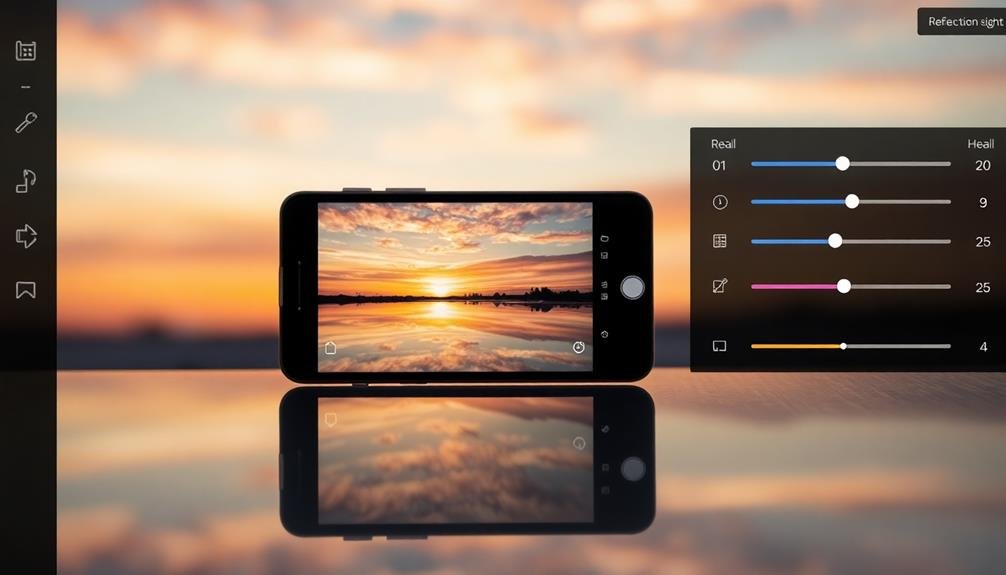
Once you've captured your mirror image shots, it's time to enhance them through editing. Start by adjusting the exposure and contrast to make your reflections pop. Increase the shadows slightly to bring out details in darker areas, and boost the highlights to emphasize the mirrored surface.
Next, focus on color correction. Adjust the white balance to guarantee accurate hues, and consider increasing saturation for a more vibrant look. Don't overdo it, though; aim for a natural appearance. Use the clarity tool sparingly to enhance texture without making the image look artificial.
Crop your photo to improve composition if needed. The rule of thirds can be particularly effective for reflection shots. Consider using symmetry tools to perfect the alignment of your mirrored image.
For a dreamlike effect, try adding a soft vignette or a subtle blur to the edges. This can draw attention to the central reflection. Experiment with selective adjustments to enhance specific areas of the image without affecting others.
Overcoming Common Reflection Photography Challenges
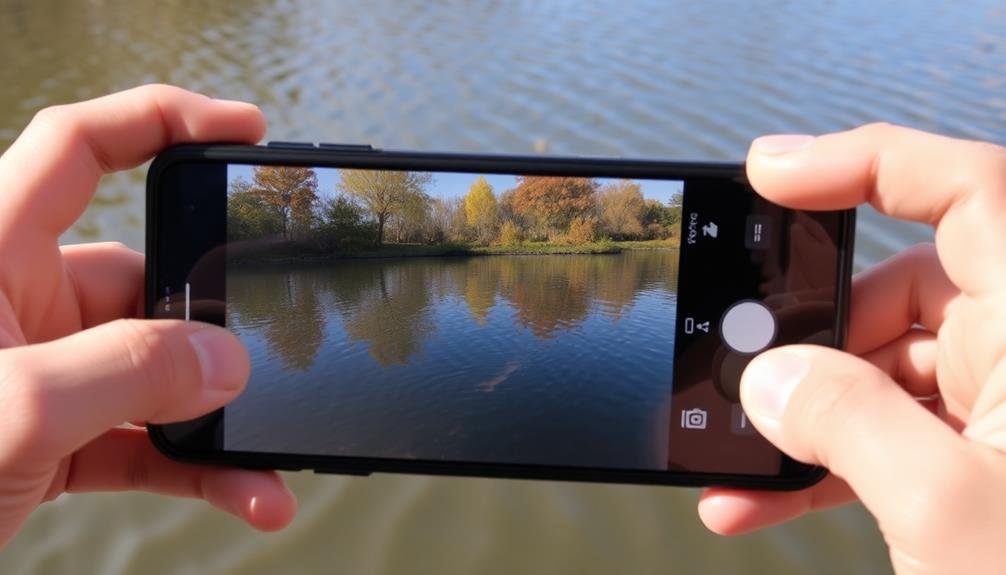
Reflection photography challenges can often stump even experienced mobile photographers. You'll frequently encounter issues like unwanted reflections, uneven lighting, and difficulty focusing. To combat these, try using a polarizing filter attachment for your phone's camera. It'll reduce glare and enhance the reflection's clarity.
When dealing with uneven lighting, expose for the brightest part of the scene and use editing tools to bring out details in darker areas. If you're struggling with focus, tap on the reflection itself to set your focal point. For clearer reflections, get as close to the reflective surface as possible.
Wind can be a major problem for water reflections. Combat this by using a faster shutter speed or waiting for a calm moment. In urban settings, you might face issues with dirty or scratched surfaces. Look for cleaner areas or embrace the imperfections as part of your composition.
Lastly, don't forget about composition. Use the rule of thirds to create balance between the real subject and its reflection. Experiment with partial reflections or abstract angles to add intrigue to your shots.
Frequently Asked Questions
How Do Mirror Images Affect the Perception of Depth in Photographs?
Mirror images create an illusion of depth by duplicating your subject. They'll trick your eyes into perceiving more space, making your photos appear layered and multidimensional. You'll notice enhanced visual interest and a sense of expanded perspective.
Can Mirror Image Photography Be Effectively Used for Product Shots?
You can effectively use mirror image photography for product shots. It'll create a unique, eye-catching display that doubles the visual impact. You'll showcase different angles simultaneously, making your products appear more dynamic and intriguing to potential buyers.
What Are the Best Weather Conditions for Capturing Mirror Images Outdoors?
For stunning outdoor mirror images, you'll want calm, still weather. Early mornings or late evenings are ideal, as they offer soft light and minimal wind. Overcast days can also provide excellent conditions for reflective photography.
How Can I Incorporate People Into Mirror Image Compositions Without Disrupting Symmetry?
To include people in mirror images without disrupting symmetry, you'll want to position them carefully. Try placing subjects at the center or have them mirror each other's poses. You can also use reflections to create interesting double portraits.
Are There Specific Camera Settings That Enhance Mirror Image Photography?
You'll want to focus on your camera's settings for mirror image photos. Use manual mode to control exposure, adjust your aperture for depth, and fine-tune your focus. Don't forget to enable gridlines for perfect symmetry.
In Summary
You've now got the tools to transform your mobile photography with mirror images. By mastering composition, finding reflective surfaces, and playing with symmetry, you'll create stunning shots. Don't forget to experiment with light and shadows, and refine your images with editing techniques. As you overcome common challenges, you'll develop a unique style that sets your photos apart. So grab your phone, seek out reflections, and start capturing mesmerizing mirror images today!

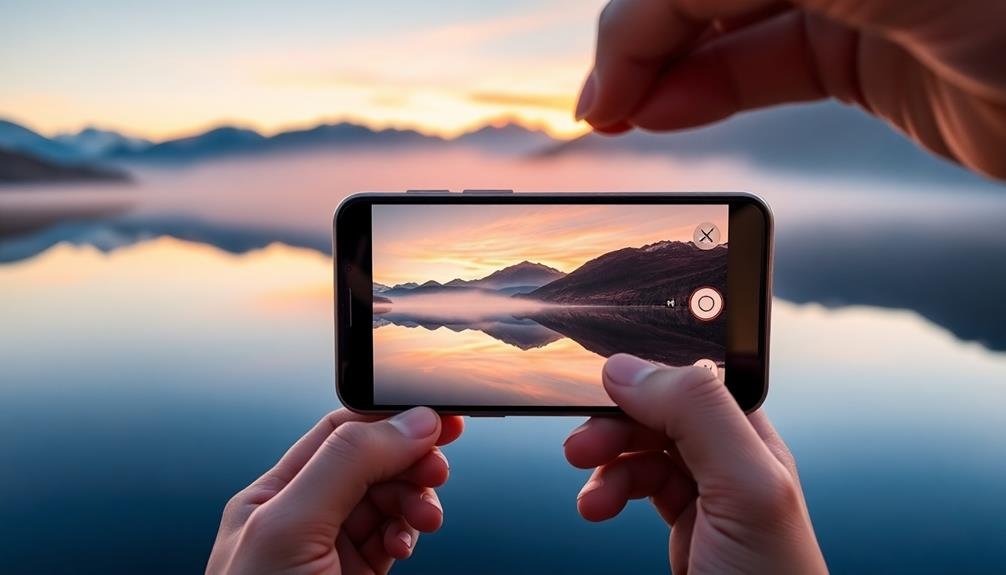



Leave a Reply